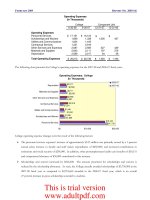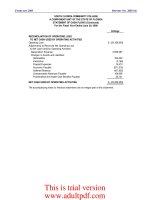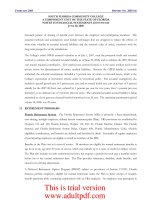REPORT NO. 2011-164 MARCH 2011 HILLSBOROUGH COMMUNITY COLLEGE Financial Audit_part3 docx
Bạn đang xem bản rút gọn của tài liệu. Xem và tải ngay bản đầy đủ của tài liệu tại đây (163.21 KB, 11 trang )
MARCH 2011 REPORT NO. 2011-164
HILLSBOROUGH COMMUNITY COLLEGE
A COMPONENT UNIT OF THE STATE OF FLORIDA
NOTES
TO FINANCIAL STATEMENTS (CONTINUED)
J
UNE 30, 2010
17
to report as an entity engaged in only business-type activities. This election requires the adoption of the
accrual basis of accounting and entitywide reporting including the following components:
Management’s Discussion and Analysis
Basic Financial Statements:
Statement of Net Assets
Statement of Revenues, Expenses, and Changes in Net Assets
Statement of Cash Flows
Notes to Financial Statements
Other Required Supplementary Information
Basis of Accounting
. Basis of accounting refers to when revenues, expenses, and related assets and
liabilities are recognized in the accounts and reported in the financial statements. Specifically, it relates to the
timing of the measurements made, regardless of the measurement focus applied. The College’s financial
statements are presented using the economic resources measurement focus and the accrual basis of
accounting. Revenues, expenses, gains, losses, assets, and liabilities resulting from exchange and
exchange-like transactions are recognized when the exchange takes place. Revenues, expenses, gains, losses,
assets, and liabilities resulting from nonexchange activities are generally recognized when all applicable
eligibility requirements, including time requirements, are met.
The College’s component unit uses the economic resources measurement focus and accrual basis of
accounting whereby revenues are recognized when earned and expenses are recognized when incurred, and
follows FASB standards of accounting and financial reporting for not-for-profit organizations.
The College follows GASB pronouncements and FASB pronouncements issued on or before
November 30, 1989, unless the FASB pronouncements conflict with GASB pronouncements. Under GASB
Statement No. 20, Accounting and Financial Reporting for Proprietary Funds and Other Governmental Entities That Use
Proprietary Fund Accounting, the College has the option to elect to apply all pronouncements of FASB issued
after November 30, 1989, unless those pronouncements conflict with GASB pronouncements. The College
has elected not to apply FASB pronouncements issued after November 30, 1989.
Significant interdepartmental sales between auxiliary service departments and other institutional departments
have been accounted for as reductions of expenses and not revenues of those departments.
The College’s principal operating activity is instruction. Operating revenues and expenses generally include
all fiscal transactions directly related to instruction as well as administration, academic support, student
services, physical plant operations, and depreciation of capital assets. Nonoperating revenues include State
appropriations, Federal and State student financial aid, American Recovery and Reinvestment Act funds,
investment income, and revenues for capital construction projects. Interest on capital asset-related debt is a
nonoperating expense.
This is trial version
www.adultpdf.com
MARCH 2011 REPORT NO. 2011-164
HILLSBOROUGH COMMUNITY COLLEGE
A COMPONENT UNIT OF THE STATE OF FLORIDA
NOTES
TO FINANCIAL STATEMENTS (CONTINUED)
J
UNE 30, 2010
18
The statement of net assets is presented in a classified format to distinguish between current and noncurrent
assets and liabilities. When both restricted and unrestricted resources are available to fund certain programs,
it is the College’s policy to first apply the restricted resources to such programs followed by the use of the
unrestricted resources.
The statement of revenues, expenses, and changes in net assets is presented by major sources and is reported
net of tuition scholarship allowances. Tuition scholarship allowances are the differences between the stated
charge for goods and services provided by the College and the amount that is actually paid by the student or
the third party making payment on behalf of the student. The College applied “The Alternate Method” as
prescribed in NACUBO Advisory Report 2000-05 to determine the reported net tuition scholarship
allowances. Under this method, the College computes these amounts by allocating the cash payments to
students, excluding payments for services, on a ratio of total aid to the aid not considered third-party aid.
The statement of cash flows is presented using the direct method in compliance with GASB Statement
No. 9, Reporting Cash Flows of Proprietary and Nonexpendable Trust Funds and Governmental Entities That Use
Proprietary Fund Accounting.
Cash and Cash Equivalents
. The amount reported as cash and cash equivalents consists of cash on hand,
cash in demand accounts, and funds invested in the State Board of Administration (SBA) Florida PRIME
investment pool, formerly known as the Local Government Surplus Fund Trust Fund Investment Pool. For
reporting cash flows, the College considers all highly liquid investments with original maturities of three
months or less to be cash equivalents. Under this definition, the College considers amounts invested in the
Florida PRIME investment pool to be cash equivalents. College cash deposits are held in banks qualified as
public depositories under Florida law. All such deposits are insured by Federal depository insurance, up to
specified limits, or collateralized with securities held in Florida’s multiple financial institution collateral pool
required by Chapter 280, Florida Statutes. Cash and cash equivalents that are externally restricted to make
debt service payments, maintain sinking or reserve funds, or to purchase or construct capital or other
restricted assets are classified as restricted.
At June 30, 2010, the College reported as cash equivalents at fair value $23,980,694 of moneys held in the
Florida PRIME Investment Pool administered by the SBA pursuant to Section 218.405, Florida Statutes.
The College’s investments in the Florida PRIME investment pool, which the SBA indicates is a Securities
and Exchange Commission Rule 2a7-like external investment pool, as of June 30, 2010, are similar to money
market funds in which shares are owned in the fund rather than the underlying investments. The Florida
PRIME investment pool carried a credit rating of AAAm by Standard & Poor’s and had a weighted-average
days to maturity (WAM) of 46 days as of June 30, 2010. A portfolio’s WAM reflects the average maturity in
days based on final maturity or reset date, in the case of floating-rate instruments. WAM measures the
sensitivity of the Florida PRIME investment pool to interest rate changes. The investments in the Florida
PRIME investment pool are reported at fair value, which is amortized cost.
Capital Assets
. College capital assets consist of land; construction in progress; buildings; other structures
and improvements; furniture, machinery, and equipment; and leasehold improvements. These assets are
This is trial version
www.adultpdf.com
MARCH 2011 REPORT NO. 2011-164
HILLSBOROUGH COMMUNITY COLLEGE
A COMPONENT UNIT OF THE STATE OF FLORIDA
NOTES
TO FINANCIAL STATEMENTS (CONTINUED)
J
UNE 30, 2010
19
capitalized and recorded at cost at the date of acquisition or at estimated fair value at the date received in the
case of gifts and purchases of State surplus property. Additions, improvements, and other outlays that
significantly extend the useful life of an asset are capitalized. Other costs incurred for repairs and
maintenance are expensed as incurred. The College has a capitalization threshold of $5,000 for tangible
personal property and $25,000 for buildings and other structures and improvements. Depreciation is
computed on the straight-line basis over the following estimated useful lives:
Buildings – 40 years
Other Structures and Improvements – 10 years
Furniture, Machinery, and Equipment:
Computer Equipment – 3 years
Vehicles, Office Machines, and Educational Equipment – 5 years
Furniture – 7 years
Pianos – 10 years
Leasehold Improvements – 40 years
Noncurrent Liabilities
. Noncurrent liabilities include bonds payable, compensated absences payable, and
other postemployment benefits payable that are not scheduled to be paid within the next fiscal year.
2. COMPONENT UNIT ADJUSTMENTS TO NET ASSETS
During the 2009-10 fiscal year, the Hillsborough Community College Foundation, Inc. (Foundation),
identified restrictions on net assets that were improperly reported in prior fiscal years, as follows:
The Foundation previously classified all endowments as restricted nonexpendable net assets;
however, some of the endowments were established by the Foundation’s Board of Directors and not
by donors. These endowments, totaling $1,146,833, were reclassified from restricted nonexpendable
net assets to restricted expendable net assets.
The Foundation previously classified the activity of Hawks Landing as restricted expendable net
assets; however, it was subsequently determined that the net assets for Hawks Landing represent
donor-imposed restrictions. The cumulative net asset deficit, totaling $587,760, for Hawks Landing
was reclassified from restricted expendable net assets to unrestricted net assets. Student housing
revenues totaling $2,401,196 for the 2008-09 fiscal year were reclassified from restricted expendable
net assets to unrestricted net assets, and net assets released from restrictions were decreased by
$3,142,496.
Unrealized losses on investments of donor-designated endowments totaling $459,083 at
June 30, 2009, were reclassified from restricted expendable net assets to unrestricted net assets.
In addition, the College reclassified amounts related to the Foundation’s investment is capital assets from
unrestricted net assets to invested in capital assets, net of related debt.
This is trial version
www.adultpdf.com
MARCH 2011 REPORT NO. 2011-164
HILLSBOROUGH COMMUNITY COLLEGE
A COMPONENT UNIT OF THE STATE OF FLORIDA
NOTES
TO FINANCIAL STATEMENTS (CONTINUED)
J
UNE 30, 2010
20
The following schedule shows net assets as of June 30, 2009, restated to reflect these changes.
Description Balance Additions Reductions Balance
6-30-09 6-30-09
Restated
Invested in Capital Assets,
Net of Related Debt $ $ 1,576,474$ (1,576,474)$
Restricted:
Nonexpendable:
Endowment 2,733,898 1,146,833 1,587,065
Expendable:
Grants and Loans 352,649 352,649
Scholarships 1,022,274 5,336,172 2,401,196 3,957,250
Unrestricted (168,380) 3,977,670 4,189,339 (380,049)
Total Net Assets
3,940,441$ 9,313,842$ 9,313,842$ 3,940,441$
3. INVESTMENTS
The College’s Board of Trustees has adopted a written investment policy providing that surplus funds of the
College shall be invested in those institutions and instruments permitted under the provisions of Florida
Statutes. Section 218.415(16), Florida Statutes, authorizes the College to invest in the Florida PRIME
investment pool administered by the State Board of Administration; interest-bearing time deposits and
savings accounts in qualified public depositories, as defined by Section 280.02, Florida Statutes; direct
obligations of the United States Treasury; obligations of Federal agencies and instrumentalities; securities of,
or interests in, certain open-end or closed-end management type investment companies; Securities and
Exchange Commission registered money market funds with the highest credit quality rating from a
nationally recognized rating agency; and other investments approved by the College’s Board of Trustees as
authorized by law. State Board of Education Rule 6A-14.0765(3), Florida Administrative Code, provides
that College loan, endowment, annuity, and life income funds may also be invested pursuant to Section
215.47, Florida Statutes. Investments authorized by Section 215.47, Florida Statutes, include bonds, notes,
commercial paper, and various other types of investments. Investments set aside to make debt service
payments, maintain sinking or reserve funds, or to purchase or construct capital assets are classified as
restricted.
The College’s investments at June 30, 2010, are reported at fair value, as follows:
Investment Type Amount
State Board of Administration Fund B
Surplus Funds Trust Fund 201,177$
State Board of Administration Debt
Service Accounts 6,689
Total College Investments
207,866$
This is trial version
www.adultpdf.com
MARCH 2011 REPORT NO. 2011-164
HILLSBOROUGH COMMUNITY COLLEGE
A COMPONENT UNIT OF THE STATE OF FLORIDA
NOTES
TO FINANCIAL STATEMENTS (CONTINUED)
J
UNE 30, 2010
21
State Board of Administration Fund B Surplus Funds Trust Fund
On December 4, 2007, the State Board of Administration (SBA) restructured the Local Government Surplus
Funds Trust Fund to establish the Fund B Surplus Funds Trust Fund (Fund B). Fund B, which is
administered by the SBA pursuant to Sections 218.405 and 218.417, Florida Statutes, is not subject to
participant withdrawal requests. Distributions from Fund B, as determined by the SBA, are effected by
transferring eligible cash or securities to the Florida PRIME investment pool, consistent with the pro rata
allocation of pool shareholders of record at the creation date of Fund B. One hundred percent of such
distributions from Fund B are available as liquid balance within the Florida PRIME investment pool.
At June 30, 2010, the College reported investments at fair value of $201,177 for amounts held in Fund B.
The College’s investments in Fund B are accounted for as a fluctuating net asset value pool, with a fair value
factor of 0.67353149 at June 30, 2010. The weighted-average life (WAL) of Fund B at June 30, 2010, was
8.05 years. A portfolio’s WAL is the dollar-weighted average length of time until securities held reach
maturity and is based on legal final maturity dates for Fund B as of June 30, 2010. WAL measures the
sensitivity of Fund B to interest rate changes. The College’s investment in Fund B is unrated.
State Board of Administration Debt Service Accounts
The College reported investments at fair value totaling $6,689 at June 30, 2010, in the State Board of
Administration Debt Service Accounts. These investments are used to make debt service payments on
bonds issued by the State Board of Education for the benefit of the College. The College’s investments
consist of United States Treasury securities, with maturity dates of six months or less, and are reported at fair
value. The College relies on policies developed by the State Board of Administration for managing interest
rate risk or credit risk for this account. Disclosures for the Debt Service Accounts are included in the notes
to financial statements of the State’s Comprehensive Annual Financial Report.
Component Unit Investments
Investments held by the College’s component unit at June 30, 2010 are reported at fair value as follows:
Investment Type Amount
5,179,034$
Total Component Unit Investments
5,179,034$
Open-End Mutual Funds
4. ACCOUNTS RECEIVABLE
Accounts receivable represent amounts for student fee deferments, various student services provided by the
College, uncollected commissions for food service and vending machine sales, unused credit memos, and
contract and grant reimbursements due from third parties. These receivables are reported net of a
$1,294,282 allowance for uncollectible accounts.
This is trial version
www.adultpdf.com
MARCH 2011 REPORT NO. 2011-164
HILLSBOROUGH COMMUNITY COLLEGE
A COMPONENT UNIT OF THE STATE OF FLORIDA
NOTES
TO FINANCIAL STATEMENTS (CONTINUED)
J
UNE 30, 2010
22
5. DUE FROM OTHER GOVERNMENTAL AGENCIES
This amount primarily consists of $19,060,096 of Public Education Capital Outlay allocations due from the
State for construction of College facilities.
6. DUE FROM AND TO COMPONENT UNIT/COLLEGE
The $51,931 reported as due to the component unit/due from College consists of amounts owed by the
College to the Foundation as of June 30, 2010, pursuant to a Support Agreement dated December 1, 2006.
Under the agreement, the College agrees to support the Foundation’s student housing project in anticipation
of benefits to the College and its students; and agrees to pay for utilities, security, internet service and a
maintenance technician. This agreement is in force until a Letter of Credit that is related to the project,
between the Foundation and a bank, has been terminated and no amount is owed by the Foundation to the
bank under a Reimbursement Agreement. The Letter of Credit matures on December 15, 2010. The
amount due to the Foundation at June 30, 2010, represents the total amount due since the student housing
project opened in January 2008. The Agreement also provides for the Foundation to repay the College from
project cash flow available under an indenture agreement. Due to the uncertainty of the timing of such
payment, the College has expensed the reimbursement and will recognize income when repayments are
received from the Foundation.
The $106,013 reported as due from component unit/due to College consists of amounts owed by the
Foundation to the College as of June 30, 2010, for private grants awarded by the Foundation, but not paid to
the College.
7. INVENTORIES
Inventories consist of items for resale by the campus bookstore, and are valued using the last invoice cost,
which approximates the first-in, first-out method of inventory valuation. Consumable laboratory supplies,
teaching materials, and office supplies on hand in College departments are expensed when purchased, and
are not considered material. Accordingly, these items are not included in the reported inventory
8. CAPITAL ASSETS
Capital assets activity for the fiscal year ended June 30, 2010, is shown below:
This is trial version
www.adultpdf.com
MARCH 2011 REPORT NO. 2011-164
HILLSBOROUGH COMMUNITY COLLEGE
A COMPONENT UNIT OF THE STATE OF FLORIDA
NOTES
TO FINANCIAL STATEMENTS (CONTINUED)
J
UNE 30, 2010
23
Description Beginning Additions Reductions Ending
Balance Balance
Nondepreciable Capital Assets:
Land 26,277,839$ 1,293,000$ $ 27,570,839$
Construction in Progress 8,289,714 21,591,022 22,390,005 7,490,731
Total Nondepreciable Capital Assets
34,567,553$ 22,884,022$ 22,390,005$ 35,061,570$
Depreciable Capital Assets:
Buildings 193,598,659$ 19,946,298$ $ 213,544,957$
Other Structures and Improvements 5,344,196 1,150,707 6,494,903
Furniture, Machinery, and Equipment 9,505,706 2,389,783 246,405 11,649,084
Leasehold Improvements 6,376,319 6,376,319
Total Depreciable Capital Assets
214,824,880 23,486,788 246,405 238,065,263
Less, Accumulated Depreciation:
Buildings 64,967,779 6,092,231 71,060,010
Other Structures and Improvements 5,010,875 265,141 5,276,016
Furniture, Machinery, and Equipment 7,912,121 1,299,427 246,405 8,965,143
Leasehold Improvements 1,208,821 151,521 1,360,342
Total Accumulated Depreciation
79,099,596 7,808,320 246,405 86,661,511
Total Depreciable Capital Assets, Net
135,725,284$ 15,678,468$ $ 151,403,752$
9. DEFERRED REVENUE
As of June 30, 2010, the College reported the following amounts as deferred revenue:
Description Amount
Student Tuition and Fees 267,070$
Commissions 100,000
Total Deferred Revenue
367,070$
10. LONG-TERM LIABILITIES
Long-term liabilities of the College at June 30, 2010, include bonds payable, compensated absences payable,
and other postemployment benefits payable. Long-term liabilities activity for the fiscal year ended June 30,
2010, is shown below:
Bonds Payable
. The State Board of Education issues capital outlay bonds on behalf of the College. These
bonds mature serially and are secured by a pledge of the College’s portion of the State-assessed motor
vehicle license tax and by the State’s full faith and credit. The State Board of Education and the State Board
Description Beginning Additions Reductions Ending Current
Balance Balance Portion
Bonds Payable 2,985,000$ 2,825,000$ 3,245,000$ 2,565,000$ 235,000$
Compensated Absences Payable 3,941,880 9,766 509,516 3,442,130 500,000
Other Postemployment
Benefits Payable 379,892 243,074 76,757 546,209
Total Long-Term Liabilities
7,306,772$ 3,077,840$ 3,831,273$ 6,553,339$ 735,000$
This is trial version
www.adultpdf.com
MARCH 2011 REPORT NO. 2011-164
HILLSBOROUGH COMMUNITY COLLEGE
A COMPONENT UNIT OF THE STATE OF FLORIDA
NOTES
TO FINANCIAL STATEMENTS (CONTINUED)
J
UNE 30, 2010
24
of Administration administer the principal and interest payments, investment of debt service resources, and
compliance with reserve requirements. The College had the following bonds payable at June 30, 2010:
Bond Type Amount Interest Annual
Outstanding Rates Maturity
(Percent) To
State Board of Education
Capital Outlay Bonds:
Series 2009A 2,565,000$ 3 - 5 2019
Annual requirements to amortize all bonded debt outstanding as of June 30, 2010, are as follows:
Fiscal Year State Board of Education Capital Outlay Bonds
Ending June 30 Principal Interest Total
2011 235,000$ 118,550$ 353,550$
2012 245,000 111,500 356,500
2013 255,000 101,700 356,700
2014 260,000 91,500 351,500
2015 280,000 78,500 358,500
2016-2019 1,290,000 165,750 1,455,750
Total
2,565,000$ 667,500$ 3,232,500$
On August 15, 2009, the State Board of Education issued $52,915,000 of State Board of Education Capital
Outlay Bonds, Series 2009A. The College’s portion of the bonds, $2,825,000, was used to refund $2,985,000
of outstanding State Board of Education Capital Outlay Bonds, Series 1999A. As a result of the refunding,
the College had a debt service savings of $257,827 and obtained an economic gain of $226,118.
Bonds Payable – Component Unit
. The Hillsborough Community College Foundation, Inc.
(Foundation), issued Student Housing Revenue Bonds, Series 2006 in the amount of $18.6 million on
December 6, 2006. Interest on the bonds is payable at a variable rate equal to the municipal swap index rate,
which was 0.23 percent at June 30, 2010. In conjunction with the issuance of the bonds, the Foundation
entered into an interest rate swap agreement to effectively fix the interest rate on the bonds at 3.59 percent.
The bonds mature on December 1, 2033. The proceeds raised from the issuance of the bonds were used to
construct a 420-bed student housing facility which serves as collateral for the bonds. The future scheduled
maturities of the bonds are as follows:
Years Ending June 30 Principal
2011 325,000$
2012 400,000
2013 470,000
2014 495,000
2015 520,000
2016-2033 15,790,000
Total
18,000,000$
This is trial version
www.adultpdf.com
MARCH 2011 REPORT NO. 2011-164
HILLSBOROUGH COMMUNITY COLLEGE
A COMPONENT UNIT OF THE STATE OF FLORIDA
NOTES
TO FINANCIAL STATEMENTS (CONTINUED)
J
UNE 30, 2010
25
In conjunction with the issuance of the bonds, the Foundation also entered into an $18.6 million letter of
credit agreement that serves as security for the bonds. The letter of credit expires on December 15, 2010.
There was no outstanding balance on the letter of credit at June 30, 2010. The letter of credit is subject to
certain restrictive financial covenants that the Foundation must maintain with respect to debt service
coverage. As of June 30, 2010, management believes the Foundation is in compliance with all covenants.
The Foundation pays an annual letter of credit fee based on a percentage of the outstanding balance on the
bonds. That percentage ranges from 0.85 percent to 1.15 percent depending on the Foundation’s debt
service coverage ratio. During the continuance of any event of default, the applicable percentage is 2
percent.
Upon certain circumstances, the interest rate may be converted to a fixed rate. As long as the bonds carry a
variable interest rate, they can be redeemed at the option of the bondholders. The Foundation has entered
into an agreement that provides for the remarketing, to the extent possible, of the bonds in the event of
redemption. In the event remarketing is unsuccessful, the letter of credit will be drawn upon to pay the
trustee. The letter of credit is due the earlier of its expiration date or 180 days from the date of draw.
Bond issuance costs of $311,288 are being amortized over the life of the bonds using the straight line
method, which approximated the effective interest method. Bond issuance costs consist of the following:
Amount
Bonds Underwriter's Discount and Issue Costs 311,288$
Less, Accumulated Amortization (31,085)
Total
280,203$
Compensated Absences Payable
. College employees may accrue annual and sick leave based on length of
service, subject to certain limitations regarding the amount that will be paid upon termination. The College
reports a liability for the accrued leave; however, State appropriations fund only the portion of accrued leave
that is used or paid in the current fiscal year. Although the College expects the liability to be funded
primarily from future appropriations, generally accepted accounting principles do not permit the recording
of a receivable in anticipation of future appropriations. At June 30, 2010, the estimated liability for
compensated absences, which includes the College’s share of the Florida Retirement System and FICA
contributions, totaled $3,442,130. The current portion of the compensated absences liability is the amount
expected to be paid in the coming fiscal year, and represents payments for employees in the final year of the
Deferred Retirement Option Program.
Other Postemployment Benefits Payable
. The College follows Governmental Accounting Standards
Board (GASB) Statement No. 45, Accounting and Financial Reporting by Employers for Postemployment Benefits Other
Than Pensions, for certain postemployment benefits administered by the College.
Plan Description. The Other Postemployment Benefits Plan (Plan) is a single-employer defined-benefit plan
administered by the College. Pursuant to the provisions of Section 112.0801, Florida Statutes, former
This is trial version
www.adultpdf.com
MARCH 2011 REPORT NO. 2011-164
HILLSBOROUGH COMMUNITY COLLEGE
A COMPONENT UNIT OF THE STATE OF FLORIDA
NOTES
TO FINANCIAL STATEMENTS (CONTINUED)
J
UNE 30, 2010
26
employees who retire from the College are eligible to participate in the College’s health and hospitalization
plan for medical, prescription drug, dental, vision, and life insurance coverage. The College subsidizes the
premium rates paid by retirees by allowing them to participate in the plan at reduced or blended group
(implicitly subsidized) premium rates for both active and retired employees. These rates provide an implicit
subsidy for retirees because, on an actuarial basis, their current and future claims are expected to result in
higher costs to the plan on average than those of active employees. The College does not offer any explicit
subsidies for retiree coverage. Retirees are required to enroll in the Federal Medicare program for their
primary coverage as soon as they are eligible. The College does not issue a stand-alone report and the plan is
not included in the annual report of a public employees’ retirement system or another entity.
Funding Policy. Plan contribution requirements and benefits may be amended by the Board of Trustees.
Benefits under the Plan are pursuant to provisions of Section 112.0801, Florida Statutes. The College has
not advance-funded or established a funding methodology for the annual other postemployment benefit
(OPEB) costs or the net OPEB obligation, and the plan is financed on a pay-as-you-go basis. For the 2009-
10 fiscal year, 28 retirees received postemployment health care benefits and 87 retirees received life insurance
benefits. The College provided required contributions of $76,757 toward the annual OPEB cost, comprised
of benefit payments made on behalf of retirees for claims expenses (net of reinsurance), administrative
expenses, and reinsurance premiums. Retiree contributions totaled $298,272.
Annual OPEB Cost and Net OPEB Obligation. The College’s annual OPEB cost (expense) is calculated based
on the annual required contribution (ARC), an amount actuarially determined in accordance with the
parameters of GASB Statement No. 45. The ARC represents a level of funding that if paid on an ongoing
basis is projected to cover normal cost each year and amortize any unfunded actuarial liabilities over a period
not to exceed 30 years. The following table shows the College’s annual OPEB cost for the year, the amount
actually contributed to the plan, and changes in the College’s net OPEB obligation:
Description Amount
Normal Cost (Service Cost for One Year) 162,348$
Amortization of Unfunded Actuarial
Accrued Liability 82,372
Annual Required Contribution
244,720
Interest on Net OPEB Obligation 11,397
Adjustment to Annual Required Contribution (13,043)
Annual OPEB Cost (Expense)
243,074
Contribution Toward the OPEB Cost (76,757)
Increase in Net OPEB Obligation
166,317
Net OPEB Obligation, Beginning of Year 379,892
Net OPEB Obligation, End of Year
546,209$
This is trial version
www.adultpdf.com
MARCH 2011 REPORT NO. 2011-164
HILLSBOROUGH COMMUNITY COLLEGE
A COMPONENT UNIT OF THE STATE OF FLORIDA
NOTES
TO FINANCIAL STATEMENTS (CONTINUED)
J
UNE 30, 2010
27
The College’s annual OPEB cost, the percentage of annual OPEB cost contributed to the plan, and the net
OPEB obligation as of June 30, 2010, and for the transition and preceding years were as follows:
Fiscal Year Annual Percentage of Net OPEB
OPEB Cost Annual Obligation
OPEB Cost
Contributed
Beginning Balance, July 1, 2007 $ $
2007-08 267,865 27.2% 195,019
2008-09 267,215 30.8% 379,892
2009-10 243,074 31.6% 546,209
Funded Status and Funding Progress. As of July 1, 2009, the most recent valuation date, the actuarial accrued
liability for benefits was $2,399,186 and the actuarial value of assets was $0, resulting in an unfunded
actuarial accrued liability of $2,399,186 and a funded ratio of 0 percent. The covered payroll (annual payroll
of active participating employees) was $55,213,729 for the 2009-10 fiscal year, and the ratio of the unfunded
actuarial accrued liability to the covered payroll was 4.3 percent.
Actuarial valuations of an ongoing plan involve estimates of the value of reported amounts and assumptions
about the probability of occurrence of events far into the future. Examples include assumptions about
future employment and termination, mortality, and healthcare cost trends. Amounts determined regarding
the funded status of the plan and the annual required contributions of the employer are subject to continual
revision as actual results are compared with past expectations and new estimates are made about the future.
The Schedule of Funding Progress, presented as required supplementary information following the notes to
financial statements, presents multiyear trend information that shows whether the actuarial value of plan
assets is increasing or decreasing over time relative to actuarial accrued liabilities for benefits.
Actuarial Methods and Assumptions. Projections of benefits for financial reporting purposes are based on the
substantive plan provisions, as understood by the employer and participating members, and include the types
of benefits provided at the time of each valuation and the historical pattern of sharing of benefit costs
between the employer and participating members. The actuarial methods and assumptions used include
techniques that are designed to reduce the effects of short-term volatility in actuarial accrued liabilities and
the actuarial value of assets consistent with the long-term perspective of the calculations.
The College’s OPEB actuarial valuation as of July 1, 2009, used the projected unit credit actuarial method to
estimate the unfunded actuarial liability as of June 30, 2010, and the College’s 2009-10 fiscal year ARC. This
method was selected because it is the same method used in the private sector for determination of retiree
medical liabilities. Because the OPEB liability is currently unfunded, the actuarial assumptions included a 3
percent rate of return on invested assets, which is the College’s expectation of investment returns. The
actuarial assumptions also included a payroll growth rate of 3 percent per year, and an annual healthcare cost
trend rate of 8 percent for the 2009-10 fiscal year, reduced by 0.1 to 0.3 percent per year thereafter, to an
ultimate rate of 4.5 percent after 18 years. The unfunded actuarial accrued liability is being amortized over
This is trial version
www.adultpdf.com









